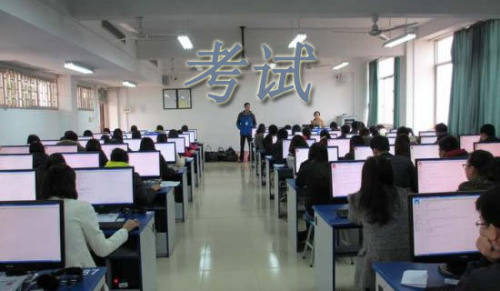
- 相关推荐
12月大学英语四级考试模拟试卷及答案(精选2套)
为您整理了“12月大学英语四级考试模拟试卷及答案”,方便广大网友查阅!更多大学英语四六级考试相关信息请访问大学英语四六级考试网。

12月大学英语四级考试模拟试卷及答案 1
Part I Writing
Directions: For this part, you are allowed 30 minutes to write a composition on the topic: Overseas Study at an Early Age. You should write at least 150 words following the outline given below:
1. 目前很多父母在子女高中毕业前就送他们出国学习
2. 形成这种趋势的原因
3. 我对些的`看法
Oversea Study at an Early Age
Part II Reading Comprehension (Skimming and Scanning)
Directions: In this part, you will have 15 minutes to go over the passage quickly and answer the questions on Answer sheet1.
The Skys Limit
Air travel is a rapidly growing source of greenhouse gases. But it is also an indispensable way of travel. The new A380 The double-decker A380, the biggest airliner the world has seen, landed at Heathrow last month to test whether Londons main airport could handle the new 550-seater, due to enter commercial service at the end of this year. It was a proud moment for Britains Rolls-Royce, the makers of the aircrafts Trent 900 engines. Rolls-Royce says the four Trents on the A380 are as clean and efficient as any jet engine, and produce "as much power as 3,500 family cars". A simple calculation shows that the equivalent of more than six cars is needed to fly each passenger.
Take the calculation further: flying a fully laden A380 is, in terms of energy, like a 14km (nine-mile) queue of traffic on the road below. And that is just one aircraft. In 20 years, Airbus reckons, 1,500 such planes will be in the air. By then, the total number of airliners is expected to have doubled, to 22,000. The huge airplane alone would be pumping out carbon dioxide (CO2) at the same rate as 5 million cars.
That may not seem much compared with the 60 million vehicles that pour off assembly lines every year—or the 1 billion vehicles already on the worlds roads. But whereas cars are used roughly for about an hour or so a day, jet airliners are on the move for at least 10 hours a day. And they burn tax-free, highoctane (1) 高能量的) fuel, which dumps hundreds of millions of tonnes of CO2 into the most sensitive part of the atmosphere.
Aviation is a relatively small source of the emissions blamed for global warming, but its share is growing the fastest. The evidence is strong. As a result, aviation is increasingly attracting the attention of environmentalists and politicians. Amid much controversy, CO2caps (最高限制) and carbon-trading could soon be used to help curb aircraft emissions.
Frequent flyers, free riders
Airlines are accused of having a free ride in terms of air pollution because they pay no tax on the fuel they use for international flights. Even though todays aircraft are about 70% more efficient than those of 40 years ago, concerns over emissions have grown. Despite booming demand for air travel, many airlines are losing money. Now green campaigners want people to think twice before they fly. The opposing voice is particularly loud in Europe, where low-cost carriers are expanding fast on busy shorthaul (2) 短距离) routes. The European Parliament will vote in July on a proposal to limit aircraft emissions.
America is deeply unhappy at the prospect of its airlines being affected. Sharon Pinkerton, a senior representative of the Federal Aviation Administration insisted, on a visit to Brussels last year, that American carriers should be exempted from the scheme. This sets the scene for another transatlantic aviation dispute, to add to the two bitter and long-running disputes over subsidies to Europes Airbus and the liberalisation of air traffic between the two continents.
The airlines are growing nervous. The big international carriers represented by the International Air Transport Association (IATA) would rather Europe waited for the deliberations of a United Nations body, the International Civil Aviation Organisation (ICAO), which has set technical, legal and safety rules for more than 50 years. International aviation was excluded from the Kyoto protocol on global warming, but only on condition that, by theend of 2007, countries and airlines worked under the umbrella of ICAO to come up with a way of reducing emissions through a trading scheme.
Soon after the end of the Second World War the member governments of ICAO agreed that airlines should be free of fuel taxes. Some say this was to outlaw unilateral taxes that could distort markets, but others reckon it was done to boost the fledgling airline industry emerging from the fighting. The corollary was that aviation, unlike motor traffic and other forms of transport, would pay in a transparent manner for the infrastructure and services it required-air-traffic management, landing charges, flyover rights and so on. That was supposed to take care of the external costs. But no one in those days thought much about the environment. Counting the cost It was not until 1999 that the United Nations Intergovernmental Panel on Climate Change (IPCC) attempted to reduce the effect of aviation on the environment. Transport as a whole was judged to be responsible for about a quarter of the worlds CO2 discharges. That makes it one of the biggest sources, alongside power generation and households, as a source of the gas. Within transport, aviation accounts for about 13%. Its contribution to total man-made emissions worldwide is said to be around 3%. So why all the fuss about so little? One reason is that high-altitude emissions are probably disproportionately damaging to the environment. The nitrogen oxides from jet-engine exhausts lead to the formation of ozone, another greenhouse gas. Contrails (飞行云) are also suspected of enhancing the formation of cirrus clouds, which some scientists think adds to the global warming effect. The IPCC estimated that the overall impact on global warming of aircraft could be between two and four times that of their CO2 emissions alone, though there is no scientific consensus about the size of this multiplier.
Naturally, the airlines choose to measure the greenhouse gases they produce in the way that casts them in the best light — a trick they deploy on safety statistics, too. For instance, over half of aircraft accidents occur around take-off and landing. So accidents per passenger-mile compare very favourably with other means of transport. But at least one study has shown that, if accidents are measured per journey instead, aircraft are the second-most dangerous way of travelling, after motorcycles.
Likewise on greenhouse gases. IATA says an aircrafts fuel consumption is about the same as that of a family car, at 3.5 litres per 100 passenger-kilometres. So CO2 emissions are similar. But that is true only if the aircraft is full and the cars passenger seats are empty. And even then, a jumbo jet flying from London to Sydney would be like nearly 400 Volkswagen Polos each travelling just over 16,000km—the average distance a European drives in a year. In other words, although cars and aircraft discharge roughly the same amount of CO2for each passenger-kilometre, the aircraft travel an awful lot farther. Waiting to land
Crowded airports compound the problem. Busy runways at places such as Heathrow mean aeroplanes have to circle wastefully. The possibility of being held up ensures that pilots carry extra fuel, thereby increasing the aircrafts weight and, hence, its consumption of fuel. Other small changes could further save fuel and avoid carbon emissions: aircraft could be towed everywhere on the ground by electric vehicles. Consumers, too, can take a stand by voluntarily offsetting the carbon emissions associated with flying by paying, for instance, to have trees planted.
This week IATA said the net loss of the worlds airlines in the past six years would amount to almost $44 billion. Carriers have been hit by terrorism, war, recession, the respiratory disease SAILS and soaring oil prices. There were hopes the industry could make a small profit in 2007, but having to pay for environmental costs could change that. Yet global warming is not something that airlines, or any other industry, can shake off for ever. Sooner or later, aviation will have to shoulder the burden it imposes on the planet.
1. This passage is mainly about how the development of airline industry has affected the environment through its greenhouse gases emission.
2. It is predicted that in 20 years, the huge airplanes alone would be pumping out carbon dioxide at the same rate as 5 million cars.
3. The author compares the effect of airliners on the environment and that of the cars and concluded that the effect ofthe former is less because the number of airplanes is much smaller than that of the cars.
4. In the past, aviation industry was the smallest source of greenhouse gases emission and thus did not attract peoples attention.
5. Many airlines are having less profit today although there are more demand for air travel. 6. America is proposing an alternative plan to solve the problem of emission from airliners.
7. The airlines are mom and more nervous, and they want the problem be considered by IATA, a United Nations body.
8. ______as a whole was judged to be responsible for about a quarter of the worlds carbon dioxide discharges.
9. Although aviation accounts for only 3% of the total man-made emission, its______ are believed to be disproportionately damaging to the environment.
10. During the past six years, airline industry has been hit by terrorism, war, ______which made the industry suffer a total loss of $44 billion.
答案:
1. A 2. A 3. B 4. C 5. A 6. C 7. A
8. Transport
9. high-altitude emissions
10.recession
12月大学英语四级考试模拟试卷及答案 2
【听力部分】
短篇新闻1
News report 1
operations at one of Australias largest gold mines had to be temporarily suspended on Friday after a partial wall collapse at one of the mines dams (Question 1).The wall collapse at the cadia mine came just a few days atert wo earthquakes hit the area.
The damage to the dam wall was noticed in the late afternoon on Friday when workers found a section of the northern dam wall had"collapsed into the southern dam.
The dams contain waste products of mining and can contain materials which are harmful to the environment and human health. The dams are generally constructed using earth fill and are gradually raised over time. The company was unable to confirm whether the recent earthquakes had contributed to the dams wall collapse, but said it was conducting a thorough investigation. A company spokesperson said that operations at the site had been halted while the investigation is ongoing, and that the brake had posed no safelyithreat to workers.(Ouestion2)
Question1:
Whathappenedatone,otAustralas largestgoldmines?
Ouestion2:
hatdidjhespokespersonsayabout theincident?
短篇新闻2
News report 2
Two boys and four girls were born on Monday to the surprise of a young couple and doctors who had expected five babies. This was the first record of 6 babies being born at the same time in that region.
The doctors prepared from early in the morningtohelp deliver five tiny citizens. They were in the operating room with five teams of doctors, one for each baby (Question 3). The first five babies were detivered successfully, and all baby beds were occupied. And then allof a sudden, it turned out there was another waiting to come out.
The doctors said the babies were in healthy condition but could not go home immediatel. They needed to stay in the hospital for 2 to 3 months for medical supervision. (Question 4)
The mother, who was in stable condition, could return home a day later if all physical tests came back normal. The babys mother commented that they had already-prepared room for five babies at home, so they will have to rearrange things for their happy surprise. The new parents have yet to name the 6th baby but are considering either Lily or rose.
Question 3:
What did the hospital do for the delivery gfthe babies?
Question 4:
What did the doctor say about the newborns?
短篇新闻3
News Report 3
A Spanish island called Palmador has been bought by a family from Europe for 18 million euros.(Question 5) Island is often described as heaven on earth by holiday makers. Decades tourists have been flocking to Palmador, which is located off the southeast coast of Spain.(Question 5)They come to enjoy its unspoiled beaches and crystal-clear waters.(Question 6) Its natural beauty is protected as it lies inside a natural park.
Although Palmador is one of the most famous private lislands in the world, its seafront is public land and is a favorite destination for famous people. When the island was put up for sale, it was offered to the local government, but proved too expensive for the local authorities. It is unclear whether the new owners have the power to ban tourists from the island, but with their newfound luxury comes the responsibility for its protection and maintenance.
The island is less than two miles long and half a mile wide. (Question 5)It is said to have a remarkable location that few other private islands of this size can match. According to estate agents, Palmador is the perfect place to retreat to get away from the city noise and relax in beautiful surroundings with zero stress.(Question 7)
Question 5
What do we learn from the news report about the Spanish island Palmador?
Question 6
What do hotiday makers come to Palmador to enjoy?
Question 7
What do estate agents say about Palmador?
四级长对话1
Conversation 1
A: Hi Christis Gym Center? How can I help you.
B:Hi?Q8.Imcallingtoaskaboutthenewly scheduled gym classes. Im just wondering if l can get a discount on them.
A: Are you already a member?
B: Yes. I signed up 2 months ago but I havent been to any of the group classes yet.
A∶Can I take your name please?
B:Yes, my name is CarolFriedman.
A: Carol Friedman.Thats right and you signed up 2 monthsl ago.Q9.Currently we are offering existing members discounts off 2 of our brand new classes. Hot yoga and advanced spinning. But the discount doesnt apply to any of our regular classes. Im afraid.
B: Im only interested in the new classes, so how much of a discount is there on these 2 new classes?
A:Q10.The same discount of 20% is being offered to everyone at the door on a first-come-first-serve basis for the first month. Its a shame you missed out on the general discount. B:I see.
A: But you can get 25% off if you sign up in advance. Which of the 2 classes are-you thinking about?
B: Well I guess I am only really interested in hot yoga. Can you sign me up for the 10 week course on Thursday evenings.
A: Sure would you prefer to pay in advance?
B: No,Q11.I dont like giving my card details over the phone anyway.
A: OK then. As you are already a member, that fee for thel class will just be added to your monthly bill.
B: Thats perfect. Thanks for your help.
A: See you Thursday.
Questions 8 to 11 are based on the conversation you have just heard.
Question 8
What do we learn about the woman from the conversation?
Question 9
What is the gym center doing right now?
Question 10
What does the man say is a pity forithe woman?
Question 11
Why is the woman unwilling to pay in advance?
【选词填空】
26.L)ranging
27.H)measured
28.B)certificates
29.M) relative
30.E) differences
31.O)targeting
32.C)connected
33.D)emonstrates
34.A)acknowledge
35.F)establish
【仔细阅读部分】
46.What characterizes Japanese and Chinese foods? A
A)Variety.
B)Flavor.
C)Color.
D)Naturalness.
47.What is typical of Amenicans in the way of eating?B
A)Theyemphasizenutrition.
B)They tend to eat quite a lot.
C)They prioritize convenience.
D) They care about flavors.
48.What features in Mediterranean. Nordic and Okinawan diets?C
A)Fruits and vegetables.
B)Olive oil and red wine.
C)Seasonallocalproduce.
D)Unprooessedingredients.
49.What do people in most healthy eating cultures have in comman?D
A)They get the whole family to eat at a table.
B)They eat their meals regularly and punctually.
C) They consume plenty of cereal for breakfast.
D) They attach great importance to their meals.
50.Comgared wth the average Amencan,people in heathy Soaetes___B
A)welk at least 4 miles a day
B)doconsiderablymorewalking
C)pay more attention to body shape
D)consume a lot more organic food
51. What is the finding of the new study?C
A)Emotional intelligence helps people get along with others,
B)Emotional intelligence is generally beneficial to its bearer.
C)People who are aware of others feelings may experience more stress.
D)Peoplewhoareemotionallystressed may have trouble making friends.
52.What was the purpose of psychologist Myriam Bechtoldts experiment?B
A) To define different types of human feelings.
B) To assess the impacts of being emotionally clever,
C)To demonstrate how to distinguish different feelings.
D) To identify gender differences in emotional intelligence.
53.What does the finding of Myriam Bechtoldts study indicate?D
A)Greatoremotionalclevernessmeanslesstroubleinoneslife.
B)Emotional intelligence helps people succoed in job interviews
C) Peoples psychological wellbeing is related to various factors
D)People may suffer from having a high emotional intelligence.
54.What do we leorn about emotionalintelligencefromanumberofstucies?C
A)Peoplesufferingfromdepression are emotionally immature.
B) People who look at the dark side of life often feel depressed.
C) Some people may take advantage of it and benefit themselves.
D) Some people may lack it and are easily manipulated by others.
55. What does the author suggest sensitive individuals do?A
A) Avoid burdening themselves with othersfeelings,
B)Rid themselves of worries over worldly affairs.
C)Learn to cope with peoplesnegauve feelings.
D)Help people todeal with their troubl esinlife.
【翻译部分】
冬至是全年白昼最长,黑夜最短的一天,标志着一年中最寒冷时节的开始。东至过后,气温越来越低,人们户外活动逐渐减少,农民地里的活不多,主要忙于灌溉系统的维护和主要农作物的防冻,同时为来年春天播种做准备。中国人历年来很重视冬至,许多地方都把冬至当作一个节日,庆祝方式不尽相同,北方人有冬至吃饺子的习俗,南方人有冬至吃汤圆的传统。
Winter Solstice is the day with the shortest daytime and the longest nighttime, marking the beginning of the coldest time of a year. From this moment on, the temperature drops continuously, and people gradually reduce their outdoor ac-tivities. Farmers have less work in their field, mainly engag-ing themselves in the maintenance of the irrigation system and the prevention of freezing harm to crops to prepare for the spring sowing in the coming year.
Chinese have always been attaching so much importance to Winter Solstice that it is regarded as a festival in many places, when people celebrate it in different ways. The people in the north have the custom of eating jiaozi and those in the south the tradition of eating tangyuan.
【作文部分】
The importance of developing a healthy lifestyle among college students
范文∶
It is a truth widely accepeted that a healthy lifestyle plays an important role in college students study and life. Without it, it would be difficult for these young people to gain advantages when they compete with their peer groups.
There are a range of reasons for my point of view. Firstly, col-lege students who live a healthy life are usually stronger and more energetic, because they lead a regular life, have a habit of taking exercise, and pay attention to their psychological health. Therefore, these young people can meet more chal-lenges and thus have more confidence. Secondly, such lifestyle helps a lot when they graduate and enter the workplace. Healthy and positive young men can definitely create a good impression on their bosses, who will in turn give them more opportunities, which is beneficial for their career develop-ment. Beside, students who lead a healthy life are more charm-ing and attractive, and people around them are fond of making friends with them.
In sum, it is of great importance for college students to devel-op healthy lifestyle. In order to do so, they can make friends more with those who lead a regular and healthy life, and they should try to form good living habits, such as going to bed and getting up early, taking exercise, and eating healthily.
在大学生中培养健康生活方式的重要性
健康的生活方式在大学生的学习和生活中起着重要的作用,这是一个被广泛接受的真理。如果没有它,这些年轻人在与同龄人竞争时就很难获得优势。
我的观点的原因如下。首先,生活健康的大学生通常更强壮,更有活力,因为他们往往生活规律,有锻炼的习惯,并注意自己的.心理健康。因此,这些年轻人可以迎接更多的挑战,从而有更多的信心。其次,这样的生活方式对他们毕业后进入职场很有帮助。健康、积极的年轻人一定能给老板留下好印象,老板也会给他们更多的机会,这对他们的职业发展是有利的。此外,生活健康的学生更有魅力和吸引力,周围的人都喜欢和他们交朋友。
总之,培养大学生健康的生活方式是非常重要的。为了做到这-点,他们可以和那些有规律和健康生活的人做更多的朋友,他们应该努力养成良好的生活习惯,比如早睡早起,锻炼身体,健康饮食。
【12月大学英语四级考试模拟试卷及答案】相关文章:
中考模拟试卷英语答案12-09
高考英语模拟试卷及答案12-08
中考英语模拟试卷答案12-09
2016年12月大学英语四级考试模拟试卷及答案(8)03-09






